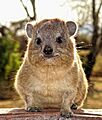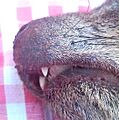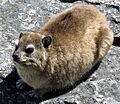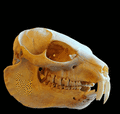Rock hyrax facts for kids
Quick facts for kids Rock Hyrax |
|
|---|---|
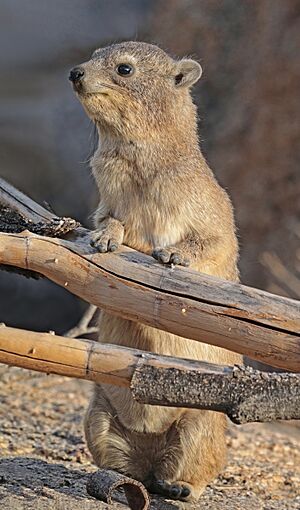 |
|
| At Erongo, Namibia | |
| Conservation status | |
| Scientific classification | |
| Genus: |
Procavia
|
| Species: |
capensis
|
| Subspecies | |
|
See text |
|
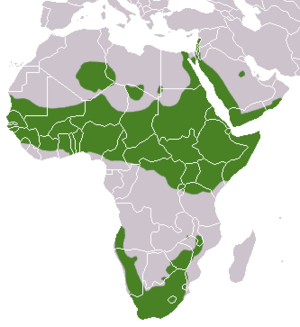 |
|
| range | |
The rock hyrax (/ˈhaɪ.ræks/), also known as the dassie or Cape hyrax, is a medium-sized mammal. It lives on land in Africa and the Middle East. In South Africa, people often call it the dassie (IPA: [dasiː]; Afrikaans: klipdassie).
The rock hyrax is part of a group of five living species called Hyracoidea. It is the only one in its specific family, Procavia. Rock hyraxes usually weigh about 4 to 5 kilograms (9 to 11 pounds) and have short ears.
You can find rock hyraxes high up in mountains, sometimes over 4,200 meters (13,800 feet) above sea level. They like places with rock cracks where they can hide from animals that hunt them. They are the only living land mammals from their group in the Middle East.
Hyraxes often live in groups of 10 to 80 animals. They look for food together. They even have special "lookouts" who warn the group if a predator is coming. They are most active in the morning and evening because their body temperature changes with the weather.
Most rock hyraxes are not in danger of disappearing. In some places, people even see them as a small nuisance. In countries like Ethiopia, Israel, and Jordan, they can carry a tiny bug that causes a sickness called leishmaniasis.
Even though they look very different, rock hyraxes are actually related to elephants and sirenians (like manatees). There's another animal in Brazil called the rock cavy that looks similar and lives in a similar way, but it's not related to the hyrax.
Contents
What Rock Hyraxes Look Like
Rock hyraxes are short and strongly built animals. Adults can grow to about 50 centimeters (20 inches) long and weigh around 4 kilograms (9 pounds). Male hyraxes are usually about 10% heavier than females.
Their fur is thick and grey-brown. However, the color can change depending on where they live. In wet places, their fur might be dark brown. In desert areas, it can be light gray. The size of a hyrax seems to depend on how much rain there is, probably because rain affects the plants they eat.
Hyraxes have a special gland on their back that gives off a smell. This smell helps them talk to each other and mark their territory. This gland is easiest to see on the main male in a group.
The rock hyrax has a pointed head, a short neck, and round ears. It has long, black whiskers on its nose. They also have two long, pointed teeth at the top, like small tusks. These teeth remind us of elephants, which are distant relatives.
Their front feet are flat on the ground, and their back feet walk on their toes. The bottom of their feet have large, soft pads. These pads stay moist with a sweat-like liquid, which helps them grip rocks.
Scientists have studied how rock hyraxes control their body temperature. Their body temperature changes throughout the day. This internal control might also help them manage how much water they have in their bodies.
Where Rock Hyraxes Live
Rock hyraxes live in many parts of sub-Saharan Africa, but not in the Congo Basin or Madagascar. They are also found in southern Algeria, Libya, Egypt, and the Middle East. This includes countries like Israel, Jordan, Lebanon, and the Arabian Peninsula. Some rock hyraxes were also brought to Jebel Hafeet, which is on the border of Oman and the United Arab Emirates.
The color of their fur can be different from one hyrax to another, and also from one region to another. The patches on their backs can be yellow, black, or spotted. In some areas, these patches are always the same color. For example, they are black in the P. c. capensis group, cream in P. c. welwitschii, and orange in P. c. ruficeps. There's also a larger group with longer hair living in the rocky areas of Mount Kenya.
Subspecies of Rock Hyrax
Scientists have identified different types of rock hyraxes, called subspecies. Sometimes, these are even considered full species:
- P. c. capensis – This is the Cape rock hyrax, found in South Africa and Namibia.
- P. c. habessinicus – This is the Ethiopian rock hyrax, found in northeastern Africa and Arabia.
- P. c. johnstoni – This is the black-necked rock hyrax, found in central and East Africa.
- P. c. ruficeps – This is the red-headed rock hyrax, found in the southern Sahara desert.
- P. c. welwitschii – This is the Kaokoveld rock hyrax, found in the Kaokoveld region of Namibia.
How Rock Hyraxes Live
Rock hyraxes make their homes in any type of rock that has good hiding spots, like cracks and caves.
On Mount Kenya, rock hyraxes live in groups. Each group has an adult male, several adult females, and young hyraxes. They are active during the day, and sometimes on moonlit nights. The main male protects the group and watches over them. He also marks his territory to show other animals where his group lives.
In Africa, hyraxes are hunted by animals like leopards, Egyptian cobras, puff adders, rock pythons, caracals, wild dogs, hawks, and owls. A bird called the Verreaux's eagle is especially good at hunting hyraxes. In Israel, land predators don't often hunt rock hyraxes. This is because their lookouts and safe hiding places keep them very protected.
What Rock Hyraxes Eat
Hyraxes eat many different kinds of plants, including broad-leafed plants. They have also been seen eating insects and grubs. They usually look for food up to about 50 meters (164 feet) from their hiding spot. They often eat as a group, with one or more hyraxes acting as lookouts from a high place. If danger comes close, the lookouts make an alarm call, and the hyraxes quickly run back to their safe spot.
They can go many days without water because they get moisture from their food. However, they can get dehydrated quickly in direct sunlight. Even though they look a bit clumsy, they can climb trees. They also like to go into gardens to eat the leaves of citrus and other trees.
The rock hyrax also makes a loud grunting sound while moving its jaws as if chewing. This behavior might be a sign of anger. Some people think that ancient Israelites saw this and mistakenly thought the hyrax "chewed the cud," like a cow. But hyraxes are not ruminants (animals that chew cud).
Reproduction and Life Cycle
Rock hyraxes usually have two to four babies after being pregnant for 6 to 7 months. This is a long time for an animal of their size! The babies are born well-developed. Their eyes are open, and they have a full coat of fur.
Young hyraxes can start eating solid food after two weeks. They stop drinking their mother's milk at 10 weeks old. They become old enough to have their own babies at 16 months. They reach their full adult size when they are 3 years old. Rock hyraxes usually live for about 10 years.
Social Behavior
Group Life
Hyraxes that live in groups where everyone shares social connections more equally tend to live longer. Scientists have also found that hyraxes follow a rule like "the friend of my friend is my friend." They try to avoid unbalanced social situations. When a group has balanced social interactions, the individual hyraxes live longer. This means that it's not just how many friends an adult hyrax has, but how well the whole group gets along. This balanced group setup might help all members get important information in their rocky homes, making it easier for the group to survive.
Talking to Each Other
Rock hyraxes in zoos make more than 20 different sounds and calls. The most common sound is a high trill, which they make when they sense danger. These calls can tell us a lot about the hyrax, like its size, age, social status, weight, and even its hormone levels. This is figured out by looking at how long their calls are, their patterns, how complex they are, and their pitch.
Recently, researchers found that rock hyrax calls have a complex structure and change depending on where the hyrax lives. This is very rare for mammals, other than primates, whales, and bats. Males with higher social status tend to sing more often, and singing doesn't use up much energy. Another study found that snorts, which are rare in male hyrax songs, are also important signals. Louder snorts can mean the hyrax is more excited or aggressive. Snorts are also linked to the singing hyrax's social status and testosterone levels. Singing also helps identify individual hyraxes, as each has a unique singing style that stays the same for years.
Resting Habits
The rock hyrax spends about 95% of its time resting. During this time, you can often see them warming themselves in the sun. Sometimes, several hyraxes will pile on top of each other. This is thought to be a way for them to help control their body temperature.
How Males Move Around
Male hyraxes are put into four groups: territorial, peripheral, early dispersers, and late dispersers. The territorial males are in charge. Peripheral males are more often alone and sometimes take over a group if the main male is gone. Early dispersers are young males who leave their birth group when they are about 16 to 24 months old. Late dispersers are also young males, but they leave their birth group much later, when they are 30 months old or more.
Names for the Rock Hyrax
In Afrikaans, the rock hyrax is called klipdas, which means "rock badger." However, most people in South Africa just call them "dassies" (the plural of dassie) or "rock rabbits." The Swahili names for them are pimbi, pelele, and wibari. The last two names are now mostly used for tree hyraxes.
This animal has many subspecies, and many of them are also called rock or Cape hyrax. The term "rock hyrax" usually refers to the African types.
In Arabic, the rock hyrax is called الوبر الصخري (Alwabr alsakhri) or طبسون (tabsoun). In Hebrew, it's called שפן סלע (shafan sela), which means "rock shafan." The meaning of shafan isn't clear, but in modern Hebrew, it's often used to mean rabbit. According to a writer named Gerald Durrell, people in Bafut, Cameroon, call the rock hyrax the n'eer.
Traditional Uses
Rock hyraxes produce a sticky substance called hyraceum, which is made of their dung and urine. In South Africa, people have used hyraceum as a traditional medicine to treat some health problems, like epilepsy and seizures. Today, perfumers use hyraceum to make a natural animal musk scent.
Rock Hyraxes in Stories
The rock hyrax is considered treif (not kosher, or unclean) in Jewish food rules. This is because of what is written in the Old Testament in Leviticus 11:5: "And the coney, because he cheweth the cud, but divideth not the hoof; he is unclean unto you." Hyraxes are also mentioned in Proverbs 30:26 as one of several amazing animals. They are small but very wise, because "the conies are a people not mighty, yet they make their homes in the cliffs."
In Joy Adamson's books and the movie Born Free, a rock hyrax named Pati-Pati was her friend for six years. This was before Elsa and her siblings came along. Pati-Pati reportedly acted like a nanny and watched over the lion cubs very carefully.
The 2013 animated movie Khumba shows several rock hyraxes.
Images for kids
-
The unusual incisors
-
Basking on Table Mountain, South Africa
-
A colony of hyraxes in northern Israel
-
Rock hyrax in the botanical garden of Pretoria, South Africa
-
Animated skull, Namibia
-
Rock hyrax (dassie) at the Cape of Good Hope, South Africa







